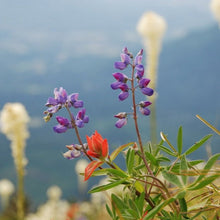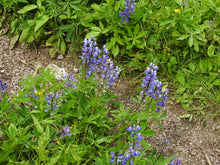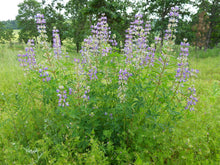Lupinus latifolius
Broadleaf Lupine is a large, densely-branching perennial that flaunts plentiful purple cone-shaped flower spires that are frequently visited by pollinators. Standing up to 4’ tall in wet sunny locations, its strong branches keep it tidy, while its deep roots stabilize soil and fix nitrogen.
- Plant type/canopy layer: deciduous, perennial, herbaceous plant
- Size at maturity: 1-4’ tall, equally wide
- Light requirements: full sun to part-sun/part-shade
- Moisture requirements: moist to wet soil
- Bloom time: April - July (May - July in the Portland Metro area)
- Growth rate/ease: medium growth rate, easy to grow
- Wildlife support: flowers attract and support bees, butterflies and other insect pollinators; overall plant is a caterpillar host and larval food source for dozens of species of native butterflies and moths
- Native habitat/range: locally common on streambanks and slopes in coastal scrub, Douglas-Fir forests, subalpine forests, mixed evergreen forest, and wetland-riparian habitats, sea-level to 2750m, from British Columbia to Baja. Portland Plant List - yes
- Special features & uses: hummingbird and pollinator magnet; drought tolerant; medicinal tea can be made from the seeds to aid urination; landscape uses include pollinator gardens, meadowscapes, erosion control and soil stabilization
Gardening with Broadleaf Lupine: Broadleaf lupine is an excellent choice for most-to-full sun locations. Though it is generally found in moist to wet soils, it is remarkably drought tolerant. It also performs beautifully in soils that are loose, rocky, shallow and/or low-fertility because its deep roots fix nitrogen, increase soil fertility, and control erosion. On research sites in the Olympic Mountains, the Forest Service found that soils directly surrounding the nitrogen-fixing broadleaf lupine plants had twice the nitrogen, more organic matter, and more phosphorus than adjacent soils, making it a valuable tool for rehabilitation of disturbed sites.
Seed Packet Contains: approximately 30 seeds
Seed Sowing Instructions: Seeds have a hard seedcoat when dormant. Therefore, they are best to sow in the fall, when no scarification is needed. However, they can be spring-sown if pre-soaked in hot water; boil water, let cool slightly then pour hot water over seeds to cover, soak for 10-12 hours, then plant.
- Seeding rate: broadcast approx 10 seeds/sq foot, 3-5 seeds per small pot, or 3-5 seeds per spot (in situ).
- Planting depth: 1/8” – 1/4”
Photo Credit 1: "Broad-leaf lupine (Lupinus latifolius), purple" by F 5.6 is licensed under CC BY-ND 2.0
Photo Credit 2: "Lupinus latifolius" by gertjanvannoord is licensed under CC BY-ND 2.0
Photo Credit 3: "Lupinus latifolius" by Willamette Biology is licensed under CC BY-SA 2.0






